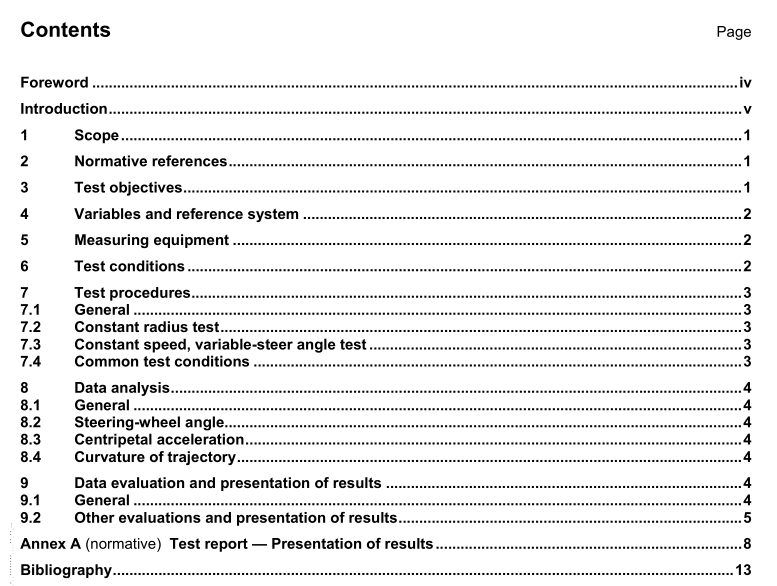ISO 14792 pdf download

ISO 14792 pdf download Road vehicles — Heavy commercial vehicles and buses — Steady-state circular tests
Although this International Standard is intended for combination vehicles as well as for single-unit vehicles, Clauses 8 and 9, regarding data analysis, evaluation and presentation, deal only with the motion variables of the single-unit vehicle or of the first unit of combinations. Thus, in order to comply with this International Standard, the user shall meet the requirements for variables, measuring equipment and data handling only in as far as they apply to the single-unit vehicle or to the first unit of combinations. Nevertheless, users are encouraged to measure and analyse the motions of trailing units as appropriate to their particular purposes.
The primary objective of this test procedure is to determine the steady-state turning characteristics of heavy vehicles for both left- and right-hand turns. The steady-state turning behaviour of unit vehicles which have more than two axles and/or dual or wide-base tyres, as is the case with most heavy vehicles, is known to be a strong function of both centripetal acceleration and path curvature [3][4] . To characterize the steady-state behaviour of these vehicles, it is therefore necessary to conduct turning tests on different radii turns as well as at varying levels of centripetal acceleration. Such a test program may be accomplished through a series of constant radius tests conducted at various radii, or through a series of constant speed, variable-steer angle tests conducted at different speeds.
Indeed, it is desirable that both types of tests be conducted for a full characterization of the steady-state turning of these vehicles. The constant radius test requires the test vehicle to be driven at a constant speed on a path of known, constant radius. The directional control response characteristics are determined from data obtained by repeating the procedure at successively higher speeds. To fully characterize the steady-turning of the vehicle, this procedure shall then be repeated for various radii. The procedure may be tailored to existing test track facilities by selecting circles or paths of appropriate radii. The constant speed, variable-steer angle test requires the test vehicle to be driven at a constant speed and constant steer angle. The directional control response characteristics are determined from data obtained by repeating the procedure at successively greater steer angles. To fully characterize the steady-turning of the vehicle, this procedure shall then be repeated at various speeds.
4 Variables and reference system
The variables to be determined may be selected for test purposes from those given in ISO 15037-2 and shall be monitored using appropriate transducers.
The variables relate to the intermediate axis system (X, Y, Z) (see ISO 8855). For the purposes of this International Standard, the reference point shall be the centre of gravity of the vehicle unit. This provision overrides the similar provision of ISO 15037-2. Strictly speaking, the steady-state turning performance ought to be evaluated based on centripetal acceleration, a c , rather than on lateral acceleration, a Y , (see ISO 8855). In most practical situations, however, the difference between these two quantities is small and can be ignored. Nevertheless, in a few cases (e.g. long-wheelbase vehicles operating on small turning radii or any vehicle operating at large body sideslip angles), the difference could be appreciable. In these cases, measured lateral acceleration needs to be corrected for sideslip angle to determine centripetal acceleration. In any case, this document refers to centripetal acceleration throughout rather than to lateral acceleration.
5 Measuring equipment
The measuring and recording equipment shall be in accordance with ISO 15037-2. 6 Test conditions The limits and specifications for ambient and vehicle test conditions shall be in accordance with ISO 15037-2.
7 Test procedures
7.1 General
The general test specifications shall be in accordance with ISO 15037-2.
7.2 Constant radius test
During this test procedure, the vehicle shall be steered such that it moves on a circular path at a constant speed. Repeat the procedure at successively faster speeds. The entire procedure should be repeated on paths of at least three different radii.









